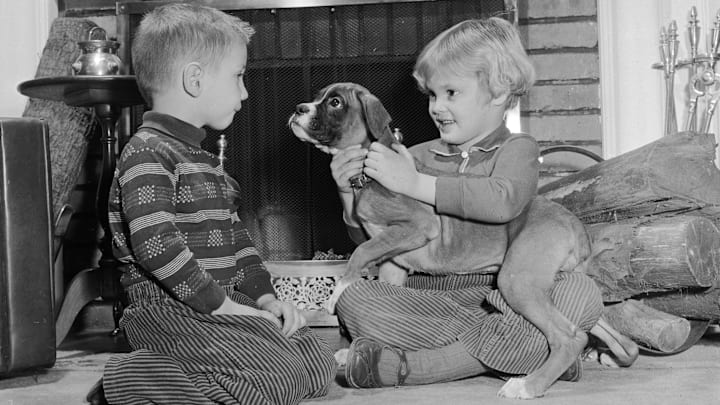Having a dog that can freely roam around the house is like living with an energetic toddler. Although Fido is more durable than a baby, your furry pal has nonretractable claws, sharper incisors and stronger jaws that can cause unintentional damage around the house. Pet-proof your space in six steps to keep it intact and your canine safe.
1. Switch to More Durable Items
Adapt to your pet’s biology by outfitting your home with scratch- and stain-resistant materials. Microfiber slipcovers resist abrasion and are washable.
Regarding flooring, tile, vinyl and laminate are hard surfaces that can take a beating from a tireless pooch trying to excavate inside the house. For carpeted areas, buy low-pile floor coverings that render it painless to clean up splatters.
2. Eliminate Toxic Substances
Dogs are naturally curious and exploratory. Your pawed companion may lick and put anything of interest to them in their mouth, potentially exposing everyone living in the house to harsh chemicals and poisons.
Use this as an opportunity to swap traditional cleaning products with eco-friendly ones. Green cleaners promote health and safety by not having notorious toxins, irritants and contaminants. All-natural products contain nothing but plant-based ingredients and essential oils. Those with synthetic ingredients that bear the EPA Safer Choice logo pose no threat to human health or the environment.
The milder your surface cleaners, stain removers, detergents, laundry boosters and dish soaps, the less dangerous they are when inhaled or ingested. However, eco-friendly isn’t necessarily pet-friendly. Search for dog-safe enzymatic cleaning products to keep Rover out of harm’s way.
3. Secure Storage Units
Closing drawers and cabinets doesn’t make their contents inaccessible to dogs. Domesticated canines learn from humans through observation. They’re smart enough to pick up how to pull or swing them open to obtain an item they need or investigate an intriguing scent by seeing how their guardians do it.
Treat your pet like a toddler and childproof every drawer and base cabinet it can reach. Many gravitate toward latches, but locks are better. The former allows doors to open slightly, providing your dog with a tiny gap to work with. Plus, they’re more straightforward to bypass. Locks keep drawers and cabinet doors shut. Some mechanisms use peel-and-stick installation and magnetic keys, eliminating the need to drill holes into the wood.
4. Organize Wires and Cables
Cords can be enticing toys for dogs. Andrew Leal — who champions pet safety and pet insurance simplicity — can attest that dogs love to gnaw at cords and inadvertently damage them. Exposed wires increase everyone’s risk of electric shocks and electrocution.
Managing cables can be a pain, but buying cord organizers and protective covers can make your life easier. Andrew also recommends hiding cables behind furniture and fastening them along the baseboards to prevent your dog from playing with them.
5. Designate No-Go Zones
Keep the areas where you store the valuables you can’t risk getting ruined off-limits to your dog. Do this as your pet gets used to the house rules. You can ease the restrictions when your four-legged friend demonstrates it’s a good housemate.
In the meantime, blockade the no-go zones. Set up a walk-through pet gate at each area’s entry point. Consider your dog’s current size and growth trajectory. This way, you can buy barriers large enough to keep it out as it grows taller and learns to jump higher.
The garden is a definite no-go zone because dogs love to dig and may eat plants and flowers. Pet-proof your vegetation with fences — especially if you have lilies and tulips — so your little buddy can play outside without worrying about your crops and ornamentals.
6. Use Positive Reinforcement When Training
Some aspects of your pet’s personality may be undesirable. Nipping unwanted behaviors in the bud is a good strategy when molding your mutt into a model housemate. However, favor reward over punishment.
Seasoned dog trainers would tell you positive reinforcement is more effective than negative reinforcement. Punishing your dog’s perceived unpleasant behavior with verbal disapproval or physical force may lead to heightened stress and increased aggression.
Conversely, rewarding your dog for commendable behaviors typically promotes trust, obedience and confidence. For example, using treats to train your pet to use its crate can motivate it and bring the two of you closer since feeding is a fun bonding activity. Once your dog feels secure in its personal space, it may voluntarily enter without extra encouragement.
Using a productive training method is the best way to pet-proof your home. You can only keep your home in one piece when you successfully teach your companion to follow your house rules when no one’s looking.
Pet-Proof Your House Properly to Live in a Harmonious Home
These pet-proofing tips don’t only ensure your property stays in good shape and your family — including your dog — in good health. They also help minimize your stress levels because living with a misbehaving canine can raise your blood pressure and expenses. Apply what you learned to create a loving environment for everyone.
